Ever since the Queen Creek ARC trip to the Mogollon rim for Field Day this year, I knew I wanted to go back and operate remotely again as a club effort to capture and build on the enthusiasm of that event. We were lucky enough that the Arizona QSO party was in October this year and provided the perfect event for anyone who wanted to take part in a “lower key” content, but at the same time, approach the event as a contest to participate in the contesting “style” of communications.
The Arizona QSO party is a 24 hour event to where the hams in Arizona “activate” or operate the various counties of Arizona, offering up contacts from those locations. Outside of AZ, hams try to work all the counties as well as many AZ hams as they can. Inside AZ, we try to work as many hams world wide as we can as part of the event. So, for us in AZ, it is another chance to get “radio active” up on the rim and work as many stations as we can – at the same time trying to maximize the different multipliers (states and modes) for each band.
At field day this year we ran a 2A station, this event we wanted to push the scale a bit and wanted to run three different transmitters for the QSO party. This meant three different radios as well as operators to staff them. Dennis, KF7RYX, would man one station in the “Bro-ham”.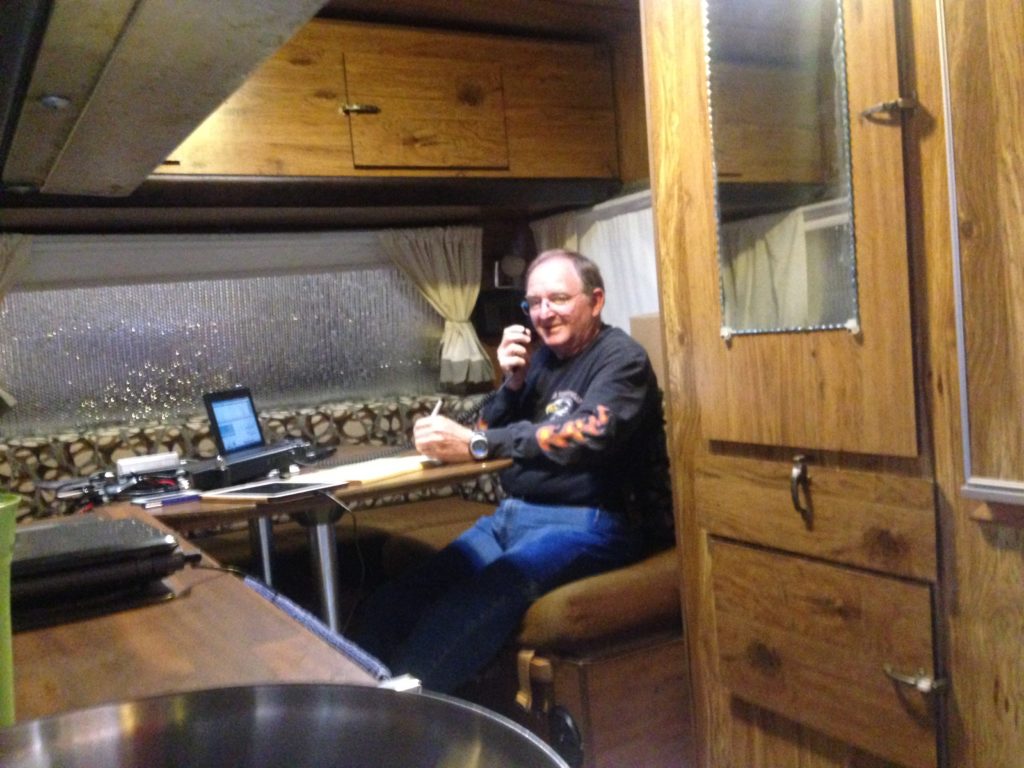
Dave, AC7FF, would handle another, with a focus on CW in his camper, and I would pick up the third station in the RV, operating the same setup as I did in Field Day this year.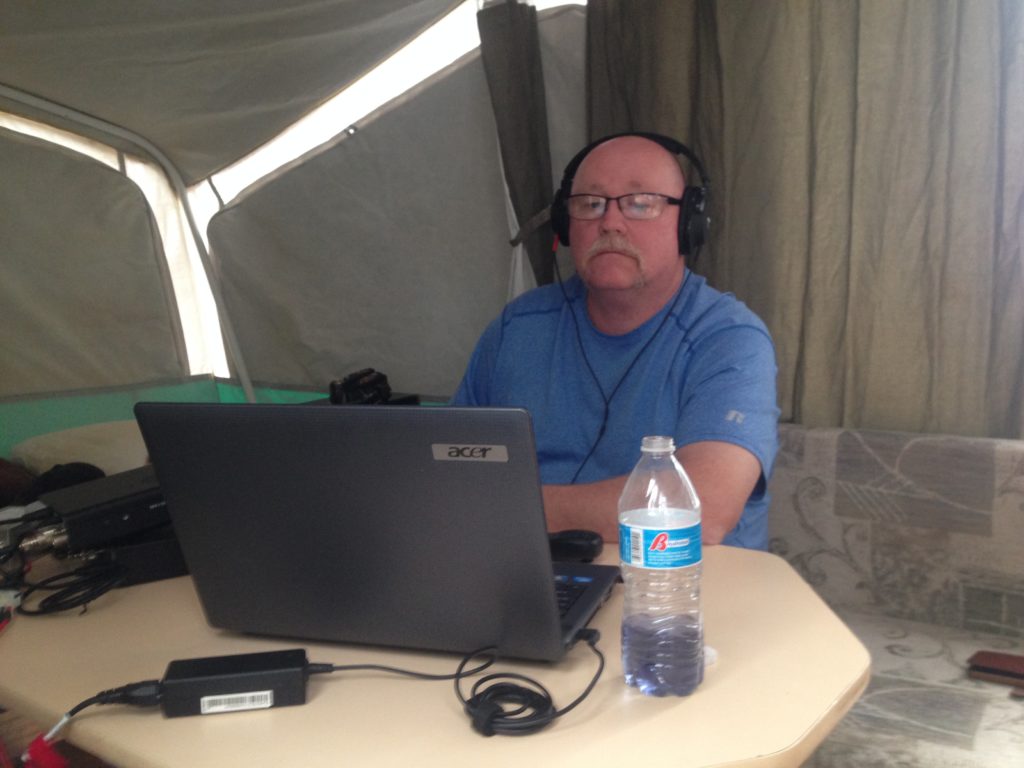
With three transmitters, we would be entered in the “Multi-Multi” category, which typically turns out HUGE numbers in contests, as you have stations dedicated by modes – which means dedicated CW stations (2 points per qso), dedicated digital stations (2 points per qso) and dedicated phone stations (1 point per qso). Needless to say, with stations focused on CW and digital contacts, scores balloon quickly!
Our multi-multi would have 2 of us on phone, and Dave switching between phone and cw depending on conditions and activity.
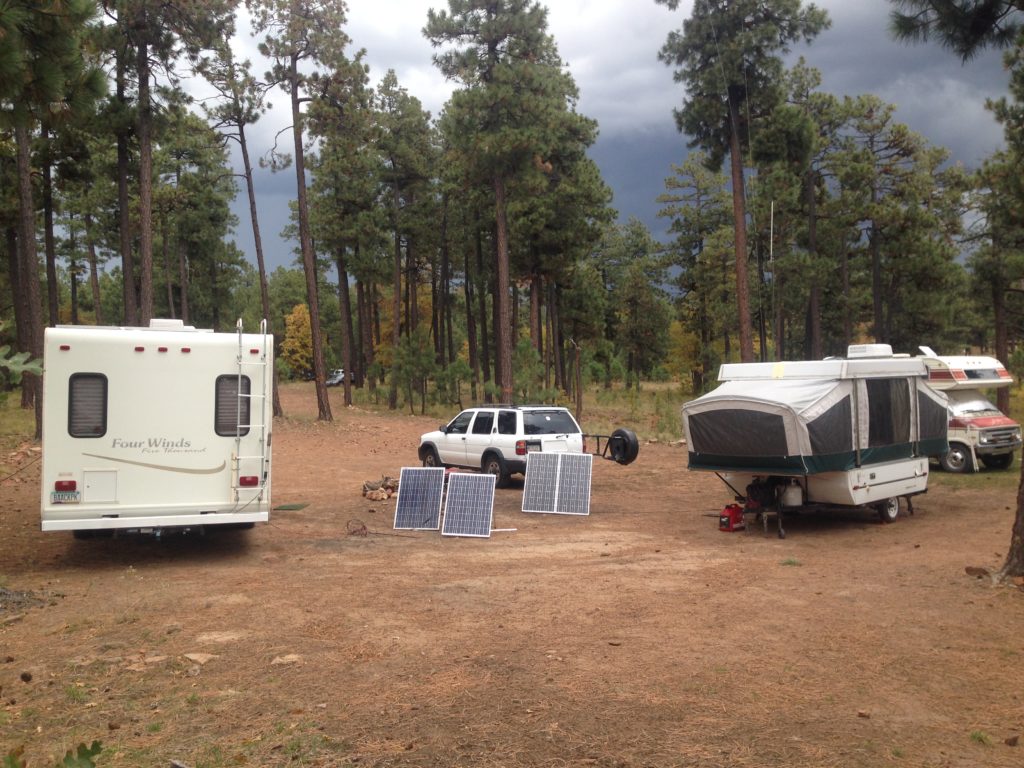
The Multi-Multi setup for the 2016 N7Q Arizona QSO Party, with storm clouds lingering..
Logging software (N3FJP)
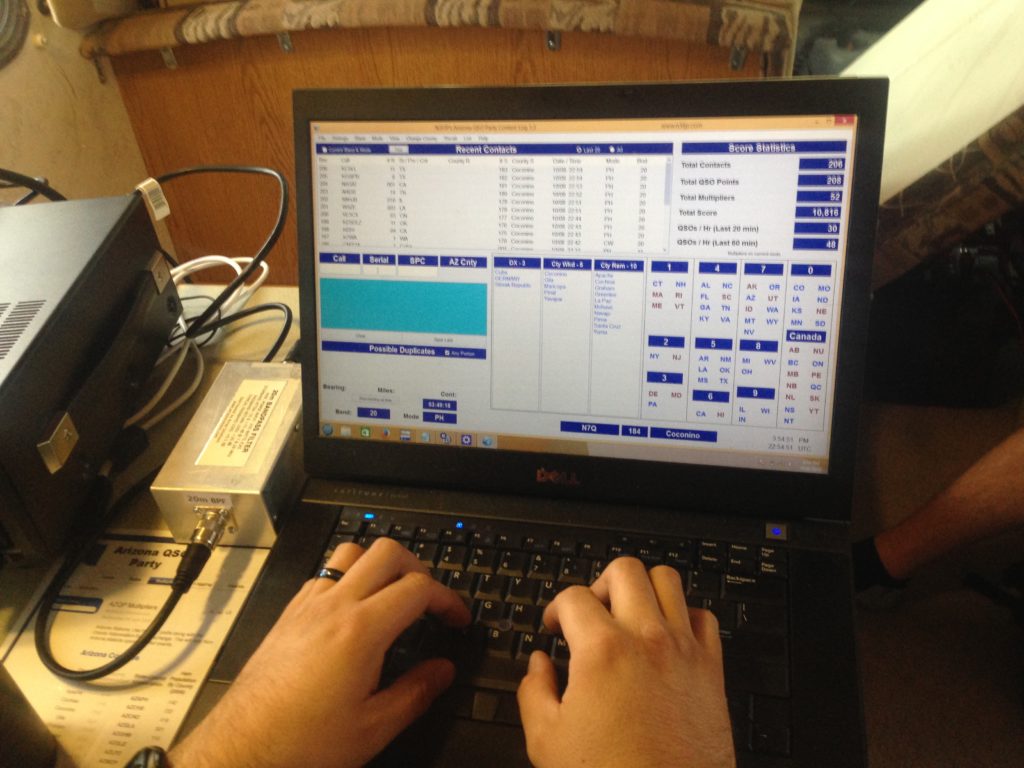
I arrived late Friday night before the event and immediately went into getting the network and the logging software setup on the laptops, as I was the last one to arrive and I had the “knowledge” on getting everything all setup.
Several hours later and several issues later, we ended up replacing one of the Windows 10 machines as it would not let us log into another machine via the network without a security issue of not accepting the password for the remote account. Then after a restart it went into a 1.5 hour mandatory “Do not turn off your machine” “update cycle”. ARRG!!!! What a PITA.
Nothing increases frustration more than when the laptop states:
“ Do not turn off your machine.. this update WILL take a while. “
Great.. lets suck down 10 amps/ hr to keep a laptop charged while it runs BS updates that we DO NOT NEED for this weekend..
After replacing that device for a Win 8 notebook, we had the network established and the laptops all configured on the wireless network to access and save to the same log. We use N3FJP’s QSO party logging software, which is very simple to use and has a nice chat feature built into it (which is slick) however, we had SEVERAL numerical issues with the log not reflecting the same numbers on the remote machine as the server machine.. I am in the process of talking with the software author as well as the support user group to figure out what was going on / how we can make sure it does NOT happen again for future events that we take part in. Dennis, Dave – I promise I will have answer on this one!
Contest Setup
Radios:
We had two FT-857s and one FTDX1200 for the event. Hand mics for the 857s and my heil Pro-set for the 1200. Band pass filters (W3NQN design) were deployed at each station for 20 and 40 meters. (These are really a MUST for this type of operation. Once you work with them, you will never want to operate in a multi transmitter environment without one.)
Antennas:
We used a combination of G5RV (or clones) and my OCF dipole. We covered NW/SE, N/S, and NE/SW with the three different antenna orientations.
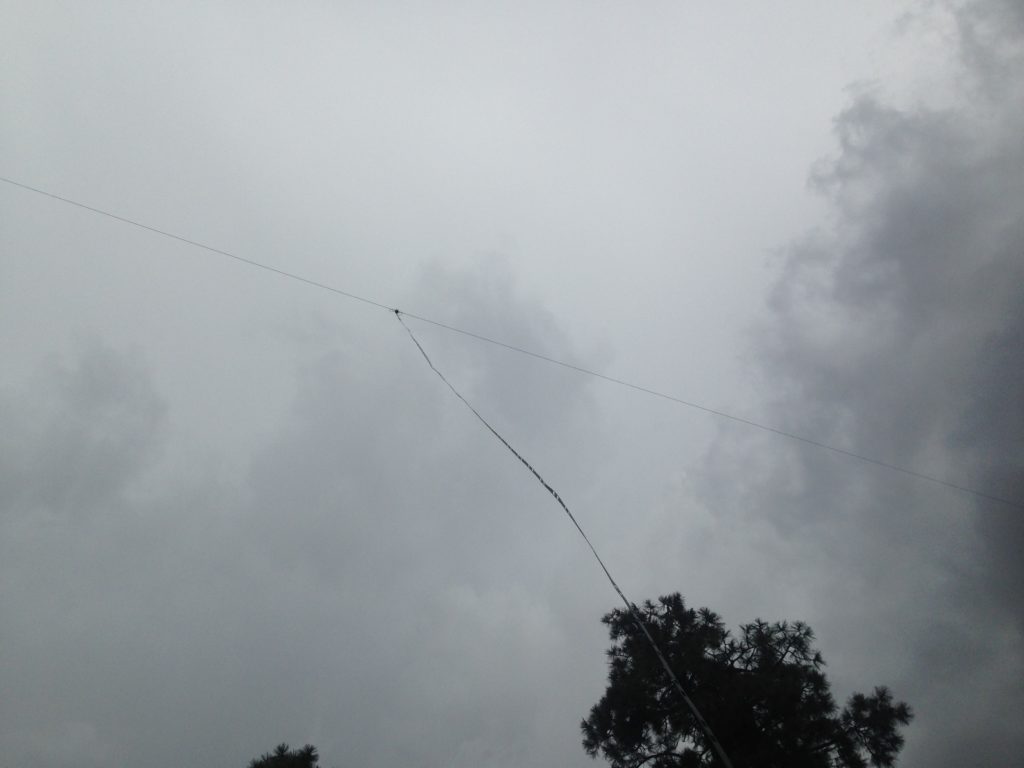
All of the antennas were 50 – 70’ up in the trees, and the various slingshot antenna launchers worked well getting them up and over the top. It was my first attempt to use my newly constructed antenna launcher, and following Dennis’ advice when looking at the first tree, “You will have to pull that back pretty far” referring to the bands on the slingshot, I ended up going over the top of not one, but three pines. A little less on the second tree ended up with another perfect shot for the placement of the antenna support line. For those who are looking for an EASY way to get antennas high in trees.. skip throwing rocks and the bow and arrow combination and build a slingshot system with a Zebco 202 or 303 reel attached. Total cost is under $15 and it works slick.
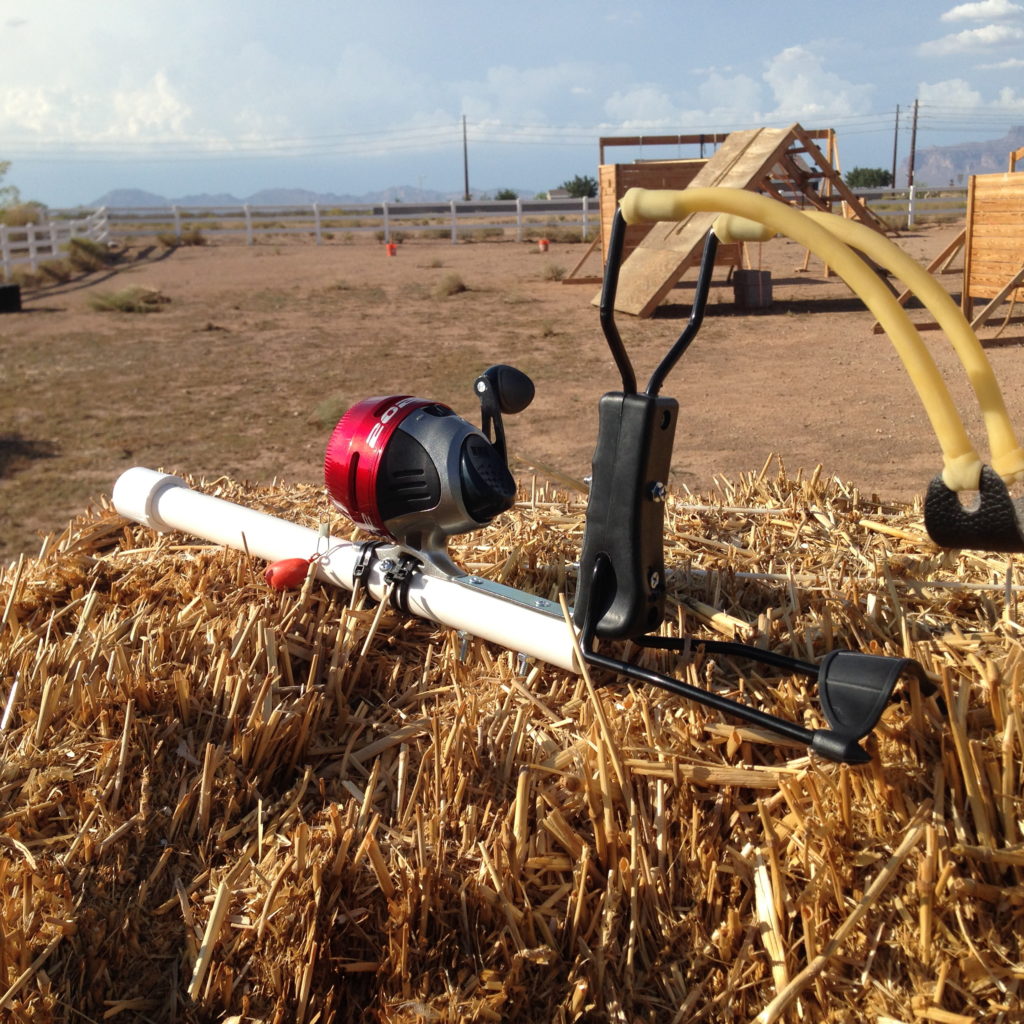
$3 sling shot, $8 reel, some PVC and 1/2 a dozen sinkers… Awesome setup.
With the three antennas had coverage from 10- 160m on HF, and primarily 15/20/40 were the bands that we operated on. 80 was quite busy Saturday night with stations, but S9+20 lightning crashes and the associated weather kept us off that band. (More on that later).
We had a mix of W7, W8 and W10 laptops, all needing to be charged at some point, using either the 120V AC laptop power cable with an inverter and connected to the batteries, or a 12V laptop power supply, going directly from the laptop to the 12V battery source, skipping the inverter.
Power
I brought along 640W of solar + the on-board 4000W generator to charge the 220Ah battery bank in the motor home, Dave borrowed and brought up 200W of solar to supplement the 1000W inverter generator that he was using to power his station. Dennis had a 1000W inverter generator, but skipped the solar this trip as he had newly installed batteries (over 400Ah worth!) and wanted to see how they would perform up on the rim with all the different electrical needs that he had.
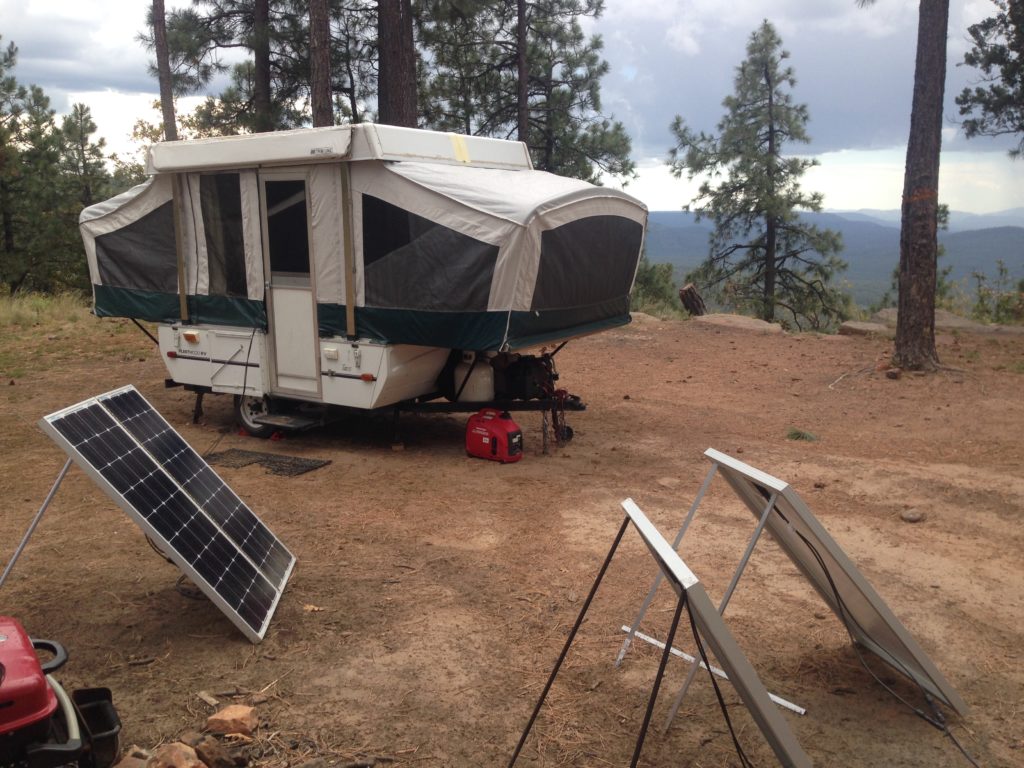
400W of portable solar + one of three generators
Needless to say we were covered in the power department.
Temps on Friday night were in the high 30s and we were subjected all night to strong winds of the approaching storm which was a nice weather change from the heat of the Metro Phoenix valley.
Saturday morning before we started the event I ended up running the generator for a few hours to bring the RV house batteries back up. after powering several laptops that had to do “updates” at 10 amps / hr to keep them charged. Since I had the Trimetric-2025 meter and all the solar installed, I had never used the generator to just recharge the batteries. With 420W of solar going into a 220Ah system, here in AZ, I can get 20 amps/ hr easy.. which tops off the batteries in less than 5 hours. However, when it ISN’T sunny here in AZ, (which is real rare) the generator is your friend. Come to find out that the converter/charger that is in the motor home only delivers about 6 amps/ hour from the generator to the batteries to charge them back up. I need to look into upgrading the system to a Smart RV converter / charger for when I need to use the generator to charge the batteries.
Expect a blog post on that new device by the end of the year..
Saturday morning also brought mixed clouds, so my standard deployment of the 2 – 100w panels to the side of the RV to capture every amp I can from the sun were only netting about 2.5 amps due to the cloud cover. The generator (while I do not like running it) was the solution to getting the batteries charged up faster and ready for the next day of radio contesting.
On the air!
Band conditions on Saturday were ‘OK to good’ – I could hear stations all over the country, but nothing as far as DX outside of Canada. The overall QSO completion rates were slower than that of Field Day, but that was to be expected as not nearly the same amount of hams were going to be on the bands. Dave was on 20 CW, I was on 20 voice and Dennis was on 40m. The band pass filters did a great job of keeping the receivers clean from out of band signals hammering each of us. I had to listen hard through Dave’s CW at times, but I quickly found his rhythm and started calling at the same time he did, which gave me a cleaner path as far as reception for the stations calling me back.
After about 2 hours, I jumped off 20 and Dave went to voice on 20, I headed to 15 and 40, switching to where Dennis was not. All the while our networked logging system was not working the way it should. Contacts were being logged, and the time stamp was correct. However, the sequential numbering system was completely messed up, and was changing to different numbers based upon activity on other bands. It didn’t make any sense, and just fueled my fire to make sure this was taken care of before we do multiple stations tied to the same log in the future. We need to make sure it works – plain and simple. Not pulling folks away from active stations to fix computer issues.
Standardized hardware would fix this solution and would make software / hardware issues easier to diagnose. As well as someone who could be dedicated to ensuring this was working as it should, and could “fill in” as an operator on breaks. This is something to investigate in the future.
Saturday morning we were covered with cloud cover with broken bits of sun, around noon the clouds moved to our north, and we were treaded with a great blue sky, which allowed us all to open windows and enjoy the sunlight and warmth that it brought. I made a point to contact one of the other QC ARC members to see if he could log on to one of the remote SDR online receivers to see if he could hear us operating on the bands. Joe, N2QOJ, was gracious enough to capture this recording of me calling CQ and working stations.
A few things I noticed in the recording, first, I might have to adjust my processor settings just a bit. The signal sounds punchy, but a bit too much low end with not enough highs. The other thing was the audio of the voice keyer was very low and didn’t match that of my voice when I was working stations. I need to pay attention to that when I setup the recordings.
Saturday afternoon the weather turned for the worse with off and on showers. Tyler, AF7VP, another QCARC club member had driven up with a friend and activated a local SOTA peak in the area. I was able to grab him easily on 20 meters, and then he came by to operate N7Q for a while.
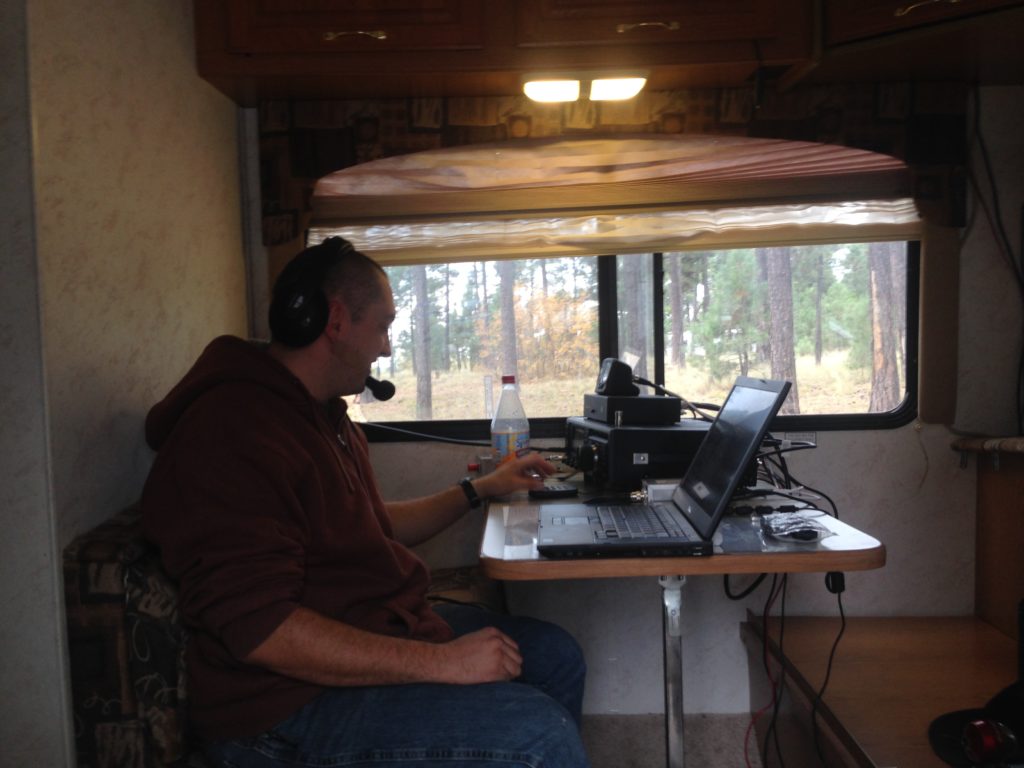 Tyler operated from my station, and got the full education of using a headset, foot switch, voice keyer, as well as using the “MONI” function to hear yourself talking in your headphones. I find the “monitor” feature very valuable as it keeps the operator from yelling into the microphone as they can hear what they sound like as they are speaking. It allows for a lower decibel voice when operating, which keeps XYLs, or anyone who is trying to rest / sleep in the same area happy, and at the same time allows you to catch yourself if you start to get tired or fail to enunciate clearly when speaking to other stations. If you have a “MONI” button on your radio.. push it and see if you like it when you operate with headphones.
Tyler operated from my station, and got the full education of using a headset, foot switch, voice keyer, as well as using the “MONI” function to hear yourself talking in your headphones. I find the “monitor” feature very valuable as it keeps the operator from yelling into the microphone as they can hear what they sound like as they are speaking. It allows for a lower decibel voice when operating, which keeps XYLs, or anyone who is trying to rest / sleep in the same area happy, and at the same time allows you to catch yourself if you start to get tired or fail to enunciate clearly when speaking to other stations. If you have a “MONI” button on your radio.. push it and see if you like it when you operate with headphones.
Video of Tyler operating the station:
Tyler, AF7VP operating at N7Q.
An hour or so later, I was back on the microphone and had a surprise contact on 20 meters. N4RVE, who was maritime mobile.. I worked him easily and asked him to confirm his state, then logged him. However the call and the /mm was stuck in my head.. I know this guy… I know this guy… A 4 land call who is maritime mobile… wait.. NO WAY!! That was STEVE – the creator of the Winnebiko, BEHEMOTH and Microship. I have chatted with him on email for years about his cycle creations as well as have several of his books in my ham library. He was one the folks who got me interested in long distance cycling, technology and solar.
One of his older creations, the winnebiko and BEHEMOTH (pictured below) that sparked my east own coast bicycle – ham radio tour.
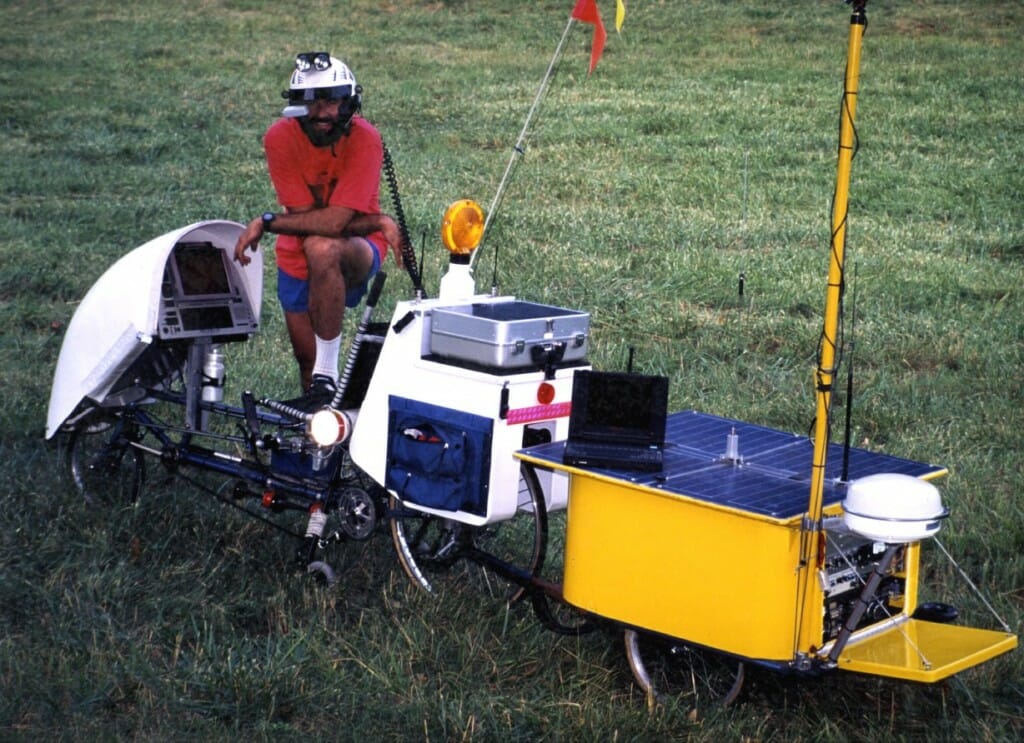 http://microship.com/wp-content/uploads/2011/08/beh-portrait1-1024×743.jpg
http://microship.com/wp-content/uploads/2011/08/beh-portrait1-1024×743.jpg
He has a massive site of his accomplishments, projects and links at the link below. Steve is a wealth of knowledge on the combination of technology and human powered vehicles. http://microship.com/
I keep thinking about that contact for the next 40 minutes and wished I would have remembered his call sooner, as I would have chatted with him for a while and put the contest on hold. (Just another reason why I love amateur radio!)
KA BOOM!
Mid afternoon the rain started picking up, and we could hear static crashes on the radio, a sign of the approaching lightning. Dave and Dennis shut down and I kept operating as I had a minor run going on 20m. Then the hail started falling, and it sounded as if 40 people were on the roof of the RV, all hitting the roof with hammers. I looked out the window and marble sized hail was starting to fall. Having never been in my RV during a hail storm, it was an interesting experience. It was very loud and very interesting to see the hail bouncing all over the ground. The storm didn’t seem to effect the band conditions other than adding a ton of static crashes on 20. As 20 meters started to die off with activity, I flipped over to 80 meters to see what the band conditions were like, knowing that Dennis or Dave would be on 40m. Wow.. Static crashes that were S9+20 were wiping out all but the strongest signals on the band. Those that I could hear were having round table rag chew conversations, and I could not find another voice station that was contesting on the band.
I tried to calling through most of it until I could see lightning, (well off in the distance) and at that point I decided to shut down for a while and just enjoy the show provided by mother nature. Seeing lighting over the valley from the rim is pretty amazing. One of the reasons is that the lighting wasn’t coming from above you, it was almost at the same height as you – so you as you look straight out over the rim, or even down a little to see the lighting exit from the base of the clouds.
A time lapse camera up there to record a valley storm would be epic.
An hour or so later (it was now close to 8 PM), the lightning had moved to the west and I got back on 20 with the goal of ending at 300 Qs that night on 20. I was clawing and scratching for the last 10.. Finally making it to 300, working a strong VE7 station. When I left the RV there was a chill in the air, and the temperature gauge was reading 54 degrees inside the RV and 44 degrees outside. I shut off the rig and headed out of the motor home to check on the rest of the crew, only to find them all hanging out talking in the “bro-ham”, which was about 80 degrees from the heat of the oven and all the bodies in the space talking. Come to find out, it was almost time for the evening sugar infusion of the cherry dump cake and ice-cream.
That was a real treat to have up here on the rim. I have to say, these 7 landers know how to eat when camping – a far cry from what I was used to eating back in 1 land with cold cans of beans and sandwiches. Dennis had made the dump cake by hand, and accompanied the creation with ice cream. It was a terrific meal with great company. Soon after I finished I graciously thanked Dennis and headed back to the motor home to try to get at least another 2 hours of solid contesting on 80 meters. As I stepped outside it started raining harder, so I jogged over to the MH and jumped in – to the entire area lighting up as if it was daylight – and a second later..
KAAAAAAAA__BOOOOOOOOOOM!
To this point, I had never been in the RV when it actually moved from the sonic rapport of a thunder clap. I now can say I have. That strike was close. I reached behind the FT-1200, disconnected the antenna feedline and threw it out the window. So much for operating the rest of the evening, my session was over for Saturday night. I prepared the coffee percolator for the morning and hit the sack.
Sunday early start
The start time for the QSO Party on Sunday came very early, 7 AM. I quickly made breakfast (eggs and fruit) plus hot percolated coffee, and started to work stations. There were plenty of stations on the bands, however, the conditions were strange. Signals would be S9+ then drop to zero. I could hear plenty of activity on the bands, audio was clear however, signal levels were all S2-S3 on the meter. When Dave would operate CW on the same band, he would trash the stations. Yesterday I could work around the CW, as the signals were much stronger. Today there were completely lost when the CW key was sending. A lot of atmospheric noise was also on the bands. My goal of 500 QSOs for the weekend was looking like it would not be possible.
By 10 AM it sounded as if there was a Faraday cage parked right over us. I could spin the dial on 20 meters and only pick up 1, maybe 2 very very weak signals. Flipping to 40 meters, I was hearing reports all over California and Texas that they were not able to hear anyone – the same conditions we were facing. I tried to stay active until 11 am, spinning the dial and only picking up 2 stations across the entire band. By 10:40 AM I had checked out mentally, and called it quits by 11, a full 6 hours early on the contest. We all determined it would be better to get torn down and on the road now, then deal with traffic in Payson later in the day.
Dennis and I poked fun at Dave for a bit… (are you done yet?? Are you done yet??) as he closed up his camper and hitched it up to the truck (all in good fun Dave) and then we departed for the valley.
All in all we ended with:
Total Contacts = 444
Total Points = 31,808
Operating Period: 2016/10/08 16:02 - 2016/10/09 17:17
Total Contacts by Band and Mode:
Band CW Phone Dig Total %
---- -- ----- --- ----- ---
40 1 51 0 52 12
20 3 371 0 374 84
15 0 15 0 15 3
10 0 1 0 1 0
2 0 2 0 2 0
-- ----- --- ----- ---
Total 4 440 0 444 100
Working all states except for three:
Vermont, New Jersey and Rhode Island.
It was interesting to see which states we had the most QSOs, considering the PA QSO party was also going on the same weekend, I expected that number to be higher, however, conditions didn’t support it.
Total Contacts by State \ Prov: State Total % ----- ----- --- WA 52 12 CA 51 11 TX 49 11 OR 27 6 AZ 20 5 GA 14 3 MI 13 3 KS 12 3 OH 10 2 OK 10 2 BC 9 2 IL 9 2 WI 9 2 AL 8 2 AR 8 2 MT 8 2 VA 8 2 CO 7 2 NC 7 2 NE 7 2 KY 6 1 MN 6 1 NY 6 1 PA 6 1 SD 6 1 FL 5 1 LA 5 1 MO 5 1 TN 5 1 IA 4 1 MS 4 1 ON 4 1 WV 4 1 WY 4 1 IN 3 1 MB 3 1 NM 3 1 NV 3 1 AK 2 0 MA 2 0 ND 2 0 AB 1 0 CT 1 0 DE 1 0 HI 1 0 ID 1 0 MD 1 0 NH 1 0 NS 1 0 NT 1 0 QC 1 0 SC 1 0 UT 1 0 Total = 53
Looking to the next rim contest event, I know of several things that we need to address before we get there, and the logging system is priority one. I know we will have this all figured out by the time we all take part in Winter Field Day (Jan 28-29, 2017) – Dave AC7FF has already said he will take the lead on that event.
Wahoo!
See you on the air. _ _ . . . . . . _ _
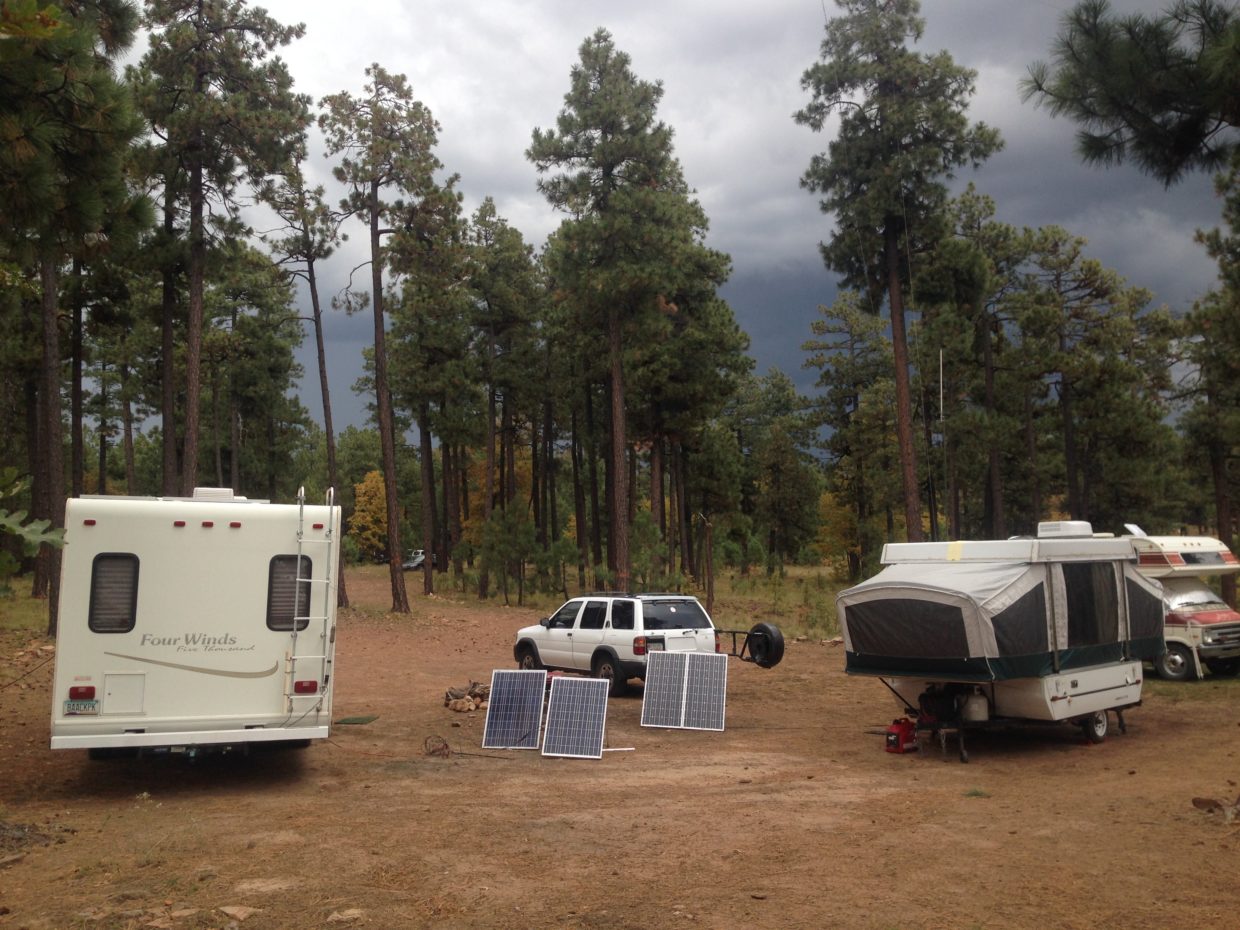
Joe October 12, 2016
Great article! Well Done – Joe, N2QOJ
n1rwy December 22, 2016 — Post Author
Thanks Joe!